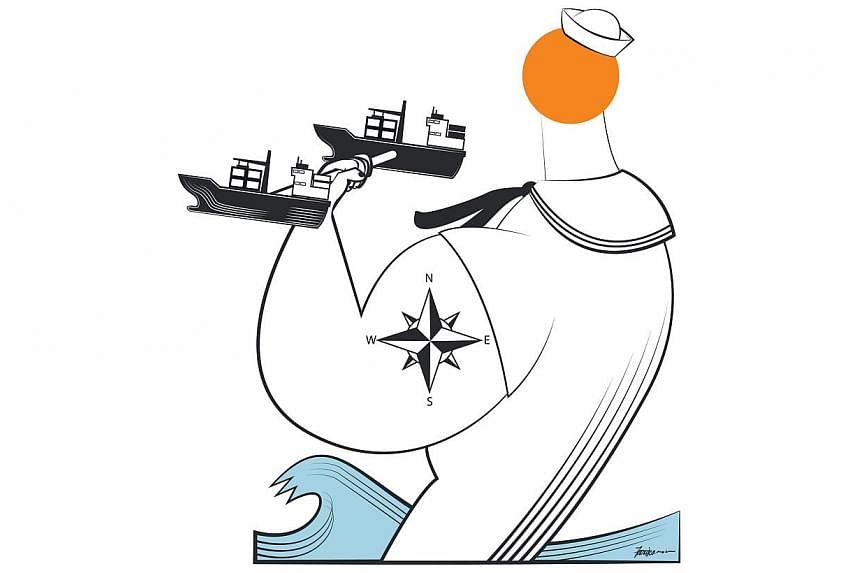I returned recently from a visit to Nara, the ancient capital of Japan. The Japanese see the city as the terminus of the traditional Silk Road and are very proud of the artefacts that reached it from the depths of Central Asia in the 8th century.
The theme of peaceful transmission of universal ideas by Buddhist monks along one of the greatest trading routes in history is one that resonates with the people today. It is a reminder of a glorious period of Eurasian connectivity when Japan looked to the continent.
At the same time, Prime Minister Shinzo Abe's re-election gave the impression of a Japan that wants to return to its normal past prior to the American Occupation after 1945. Whether intended or not, we are reminded of Japan as a great maritime power.
At its height, that power had landed powerful armies on Taiwan, the Korean peninsula, and eventually overran more than half the provinces of the Chinese mainland. It then attacked the United States in Hawaii, defeated the Western empires in South-east Asia, and pushed towards the Indian Ocean. For the first time ever, one power held sway over the whole of the South China Sea and made it into a Japanese lake.
Juxtaposing the two past and present images led me to think about the nature of maritime power in history.
Japan was a unique island nation that had never been successfully invaded. It was left alone for its warlike leaders to fight, for more than a thousand years, mostly among themselves. The last set of pre-modern rulers during the Tokugawa period actually decided to close its borders to all except a few persistent merchants. During the whole length of its history, there was no serious attempt by the Japanese to become a naval power.
What changed the course of Japanese history was the global naval power of Britain that defeated the mighty Qing empire on the mainland. The Japanese leaders observed that onslaught with anxiety and fascination.
So when the American fleet arrived off their coast in 1853, they were quick to respond to the new challenge, not only to an immediate threat, but also to an opportunity to think their destiny afresh. That amounted to a mindset revolution that created Meiji Japan and made the country the most advanced in a newly fashioned Asia of Western-dominated peoples.
The Japanese quickly realised that the only other island-based empire was Great Britain on the other side of the Eurasian continent. They studied the British closely and mastered the naval skills they needed.
They also saw that the Atlantic core of industrial capitalism was shifting to the United States and studied that phenomenon carefully as well. They recognised that the new wealth created there enabled the US to become an even greater global naval power.
In search of imperial glory, Japanese military leaders planned to replace the West as the region's dominant force. In order to do that, they saw the need for its own continental hinterland and successfully acquired that during the first decades of the 20th century. But they also knew that Anglo-American challenges at sea could be a threat to their ambitions and their security.
The European war of 1939-1945 on the other side of the continent provided a great opportunity for Japan to consolidate its gains in Asia. It led the Japanese navy to seek to control the Indo-Pacific Oceans.
We know how that story ended for Japan, and also what happened when the British were soon after forced to restructure their navy back home and the Americans took their place to rule the waves. For Japan, after it surrendered, it was given a Constitution that many now feel is no longer appropriate.
As it turned out, the Japanese rallied after the war and responded to globalisation brilliantly. Within 30 years of defeat, their country had become a global economic power and was leading economic development in Asia. Their achievements are still widely admired and the model they offered has been followed by all neighbouring countries that wished to emulate their success. The most spectacular has been post-Mao Zedong China, now the second-largest economy in the world.
There are lessons in this story that deserve closer attention. The island kingdom of Japan was the first in Asia to understand that globalisation was the product of maritime power.
What then was the nature of this power that crossed three great oceans and opened up new continents for settlement and economic exploitation? What enabled it to change the shape of the world?
The British experience shows that naval power without continental resources is vulnerable. When the British could make no headway on the European continent, they sought fresh strength from their colonies across the Atlantic.
After they lost the 13 colonies that became the United States, they found help on land in Australia, on the Indian sub-continent and parts of Africa. As long as their naval power controlled such hinterlands, they remained globally supreme. But none of them was their own continent.
The 13 colonies in America inherited and extended British naval traditions after their independence. In addition, they tamed a continent of their own. This was the first time that naval and continental power was combined securely in one country.
Both India and China had naval moments, the former with the Chola empire in South India and the latter with Emperor Yongle of the Ming dynasty sending Zheng He on his expeditions to the Indian Ocean. In both cases, continental threats held them back. They were the Muslim Afghan-Turko-Mongol armies that invaded India from Central Asia and the Mongols and Manchus who conquered China.
The contrasts are striking. Britain has naval power without a secure continental hinterland of its own. France and Germany, on the other hand, have deep continental concerns that limit their naval ambitions.
Russia has enormous continental resources but cannot easily get the access to the oceans that a global economy needs. The US, on the other hand, is safe in the Americas with resources that can support its global naval outreach entirely on its own.
Today, China and India have both awakened to the fact that the base of globalisation is maritime. As they have become integrated into the global economy, they have to think maritime. At the same time, their continental hinterlands have never been secure and neither can afford to take its eyes off its overland neighbours.
In between them is South-east Asia, unique as a region that is both maritime and continental. What is extraordinary is that it is, at the same time, seeking to make that combination into a strength and not be a constraint on its future development. There is a good chance that, with help from its contiguous regions, it will succeed.
That is the background to a new era in Asia, the next phase of globalisation that is trying to combine the maritime with the continental. Japan needs to readjust to a rising Asia that is learning to do that and wants to do it peacefully.
How will Japan respond? When I heard my Nara hosts speak fondly of the Silk Road that connected Japan to the Eurasian continent, I felt that Japan may be returning from a century of looking far to the West in order to reappraise its future in an Asia that would have to be both continental and maritime.
The writer is chairman of the East Asian Institute and a professor at the National University of Singapore.


